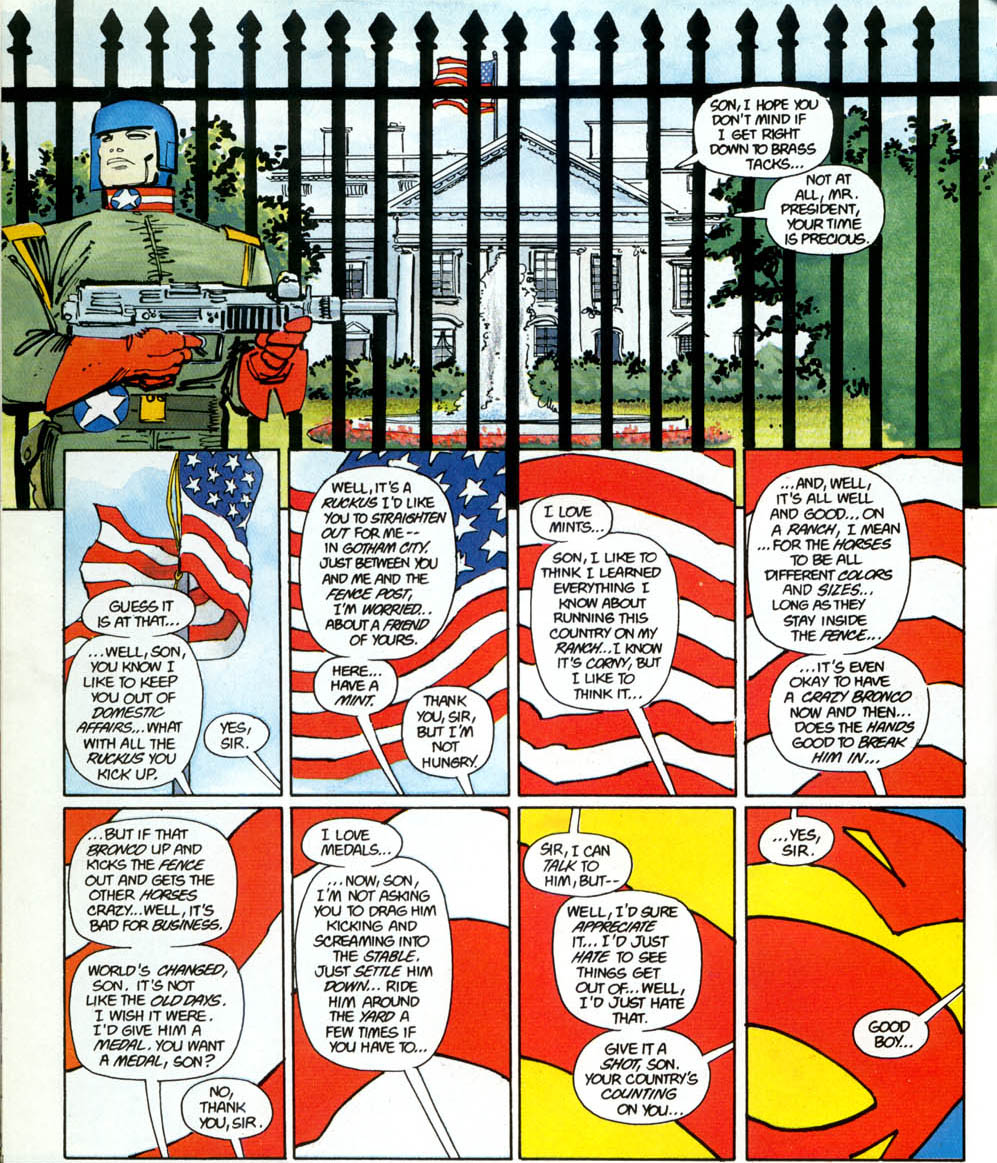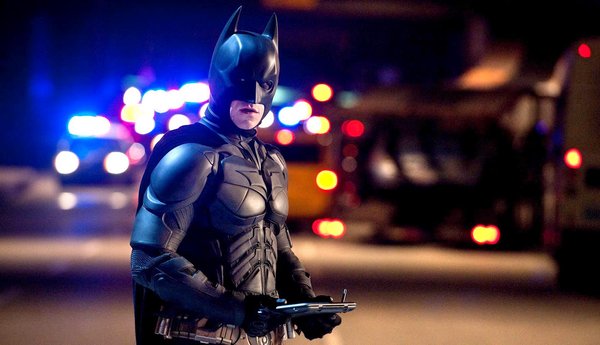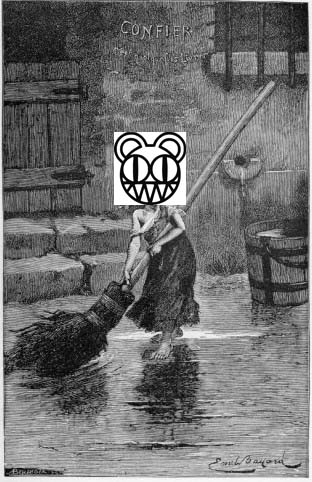Reading Frank Miller’s influences on Christopher Nolan’s Dark Knight Trilogy
One more post on the Batman, if you’ll please. It’s no secret that Christopher Nolan’s Dark Knight Trilogy drew a lot of inspiration from Frank Miller—specifically, from his 1986 mini-series Batman: The Dark Knight Returns and its 1987 follow-up, Year One (which featured art by David Mazzucchelli). And so I felt like taking some time to note all the connections (or at least the ones I can see—feel free to chime in as to what I’ve missed!).
I’ve already commented elsewhere on how Batman Begins took:
- the Tumbler design (The Dark Knight Returns);
- Batman’s escape from the police by means of a bat homing device (Year One);
- and the ending in which Commissioner Gordon muses about the arrival of the Joker, having received one of his calling cards (Year One).
And there are still more connections. Commissioner Gordon’s character arc in that film is similar to the one he follows in Year One—he even has a corrupt partner named Flass. Furthermore, Bruce Wayne distances himself from the Batman by cultivating the image of a drunken playboy:
That’s everything that I can see in the first film.
The Dark Knight is I think the least indebted to Miller of the three films. Nonetheless, its ending, wherein Two-Face kidnaps Gordon’s family, echoes the mob’s kidnapping of Gordon’s family at the conclusion of Year One—Batman even saves Gordon’s son from falling:
Moving on to the The Dark Knight Rises …
We Need to Talk About Batman
I want to argue that the conceit of Batman having a secret identity no longer works.
It once did, back in the 1930s and ’40s, when Batman was essentially a badass moonlighting in tights, socking hoodlums and thugs in their jaws. At that time, the extent of the audience’s suspension of disbelief was that the fellow wouldn’t get shot.
How simple, compared to today. The Batman of 2012 is a one-man paramilitary force capable of investing hundreds of millions of dollars into being the Caped Crusader—a one-man Blackwater USA! Frank Miller was right: there’s no way that the U.S. government would permit this guy to exist:
Why We Need Superheroes, or, A Parental Theory, or What Was Just A Review of Chronicle Before People Were Murdered While Watching The Dark Knight Rises

This July my wife, daughter, and I visited my family in California and on our return flight to Atlanta we met with a reprieve when our one-year-old fell into a deep sleep in our arms. She didn’t even wake when my wife had to use the bathroom and shifted the baby into my lap. I took this quiet opportunity to scan the movie offerings on those individual screens that some Delta flights afford passengers. The movie choices are not usually very good and the descriptions of the plots are vague, especially if you’re like me, and you hardly watch television and so remain ignorant when it comes to pop culture. I ended up selecting one of these vague choices, with an equally vague title. I didn’t know anything about Chronicle. The plot synopsis was something like “three friends chronicle their lives through a camcorder when suddenly everything changes.” I didn’t recognize the actors’ names, and I think that’s why I chose to watch it; I figured I’d try something completely unknown.
I got lucky with this choice. The movie is not very long (at 83 minutes it’s closer to the length of movies that I grew up on and not the typical two-hour epics that are common today), and I didn’t know when my daughter might wake, which would end my movie-watching experience. But she snoozed right through the whole thing, which afforded me the time to think about the ideas that coalesced in writing the first draft of what you’re reading. READ MORE >
The Ever Risable Dark Knight
In the set piece that opens The Dark Knight Rises, a CIA operative screams at three hooded captives, “The flight plan I just filed with the Agency lists me, my men, Dr. Pavel here, but only one—of you!” He then starts pretending to toss them out of his airplane, only to be interrupted by the masked terrorist Bane, who has seen through his deceit (“Perhaps he’s wondering why someone would shoot a man … before throwing him out of a plane!”). Menacing banter ensues, after which Bane gains control of the aircraft and prepares to crash it. Grabbing Dr. Pavel, he commands an underling to remain on board, because “they expect one of us in the wreckage, brother!”
This is the kind of exchange Christopher Nolan thinks clever, when really it makes no sense. The plane was riddled with bullets, its wings torn away, its tail end blown off by explosives. Obviously somebody attacked it—so who cares if the bodies in the wreckage match the flight plan? What’s more, the CIA man wasn’t telling the truth about throwing them out—Bane even commented on that—so why trust his line about the flight plan?
These might seem like nitpicking, geeky griping over plot holes. But this exchange illustrates so much of what’s so wrong with Nolan’s movies.
For one thing, his characters never shut up.
Pitchfork’s Les Misérables List
Have you seen that Pitchfork Media finally wants input from their readers, asking folks to vote for their favorite albums 1996–2012? (That’s years 1–16 Anno Pitchfork.) Between this and The Dark Knight Rises, 2012 sure has been good for the proletariat: rise up, ye 99%, and go watch a movie, and vote online! When you’re finished, you can share your list with friends via Facebook and Twitter. If you like, you can even write a little something about your #1 pick for possible inclusion in the final feature!
You can also check a box to enter a Sweepstakes to win a Trip to the Pitchfork Paris Music Festival, but make sure you READ CAREFULLY the Official Contest Rules…
Me, I can’t wait to share my commoner’s thoughts, little though they are. Off the top of my head:
1. Sonic Youth: A Thousand Leaves
2. They Might Be Giants: Mink Car
3. R.E.M.: Up
4. The Strokes: First Impressions of Earth
5. Smashing Pumpkins: Zeitgeist





